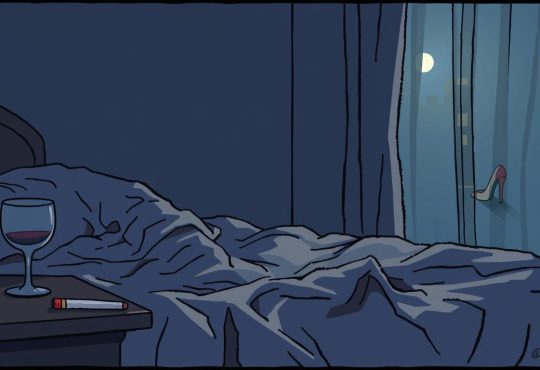
Have you ever felt invisible or questioned your self-worth because of a partner’s wandering eye? You’re not alone. Many women experience this issue, yet it’s rarely discussed openly. Daniella, for example, shared how she felt constant insecurity during family gatherings or even at the grocery store. Her story highlights a common problem in relationships.
Noticing an attractive person is natural, but when it affects your self-esteem, it’s time to take action. This article offers practical advice and expert insights to help you navigate these feelings. We’ll explore ways to strengthen your marriage, set healthy boundaries, and rebuild respect and love.
Our goal is to support you like a knowledgeable friend. Let’s work together to transform this challenge into an opportunity for growth and deeper connection in your relationship.
On this Page:
- 1 Understanding the Behavior Behind the Wandering Eye
- 2 Identifying Your Emotions and Insecurities
- 3 Effective Communication with Your Husband
- 4 what to do when your husband looks at other woman
- 5 Reinforcing Positive Relationship Behaviors
- 6 Boosting Your Self-Esteem and Confidence
- 7 Addressing Common Myths and Misconceptions About Attraction
- 8 Conclusion
Understanding the Behavior Behind the Wandering Eye
Understanding the reasons behind a wandering eye can bring clarity to your relationship. It’s a common issue that many women face, but it’s often misunderstood. Let’s explore the natural and social factors that contribute to this behavior.
Natural Attraction and Its Implications
Noticing an attractive person is a universal human behavior. It doesn’t mean your partner loves you any less. Research from the 2013 Archives of Sexual Behavior shows that both men and women are wired to notice beauty. This instinct is rooted in biology, not a lack of commitment.
Dopamine, a feel-good chemical, plays a role here. When a man sees an attractive woman, his brain releases dopamine, creating a fleeting sense of pleasure. This doesn’t reflect on your marriage or your worth. It’s simply a natural response.
Biological Instincts and Social Conditioning
Biological impulses are only part of the story. Social conditioning also shapes how men behave. Media often portrays women as objects of desire, reinforcing the idea that looking is harmless. This can make the behavior seem more acceptable, even in committed relationships.
Studies suggest that 60% of men admit to looking at other women while in a relationship. This doesn’t mean they’re unhappy or planning to cheat. It’s often a subconscious reaction, driven by instinct rather than disrespect.
Understanding these factors can help you see the behavior in a new light. It’s not about you or your marriage. It’s a combination of biology and societal influences that affect many relationships today.
Identifying Your Emotions and Insecurities
Feeling uneasy about a partner’s attention to others is a common yet deeply personal experience. Many women grapple with emotions like jealousy and insecurity when they notice their partner’s wandering eye. These feelings can stem from personal triggers or past experiences, making it essential to address them constructively.
Recognizing Personal Triggers
Understanding what triggers your emotions is the first step toward managing them. For some, it might be a specific situation, like seeing their partner glance at an attractive woman. For others, it could be a lingering insecurity from past relationships or childhood experiences.
Moshe Ratson, a relationship expert, suggests looking inward to identify these triggers. He emphasizes that past traumas often amplify current feelings of jealousy. By acknowledging these triggers, you can begin to separate past pain from present reality.
Managing Jealousy and Insecurity
Jealousy doesn’t have to control your relationship. Start by using “I” statements to express your feelings without blame. For example, say, “I feel uncomfortable when I notice your attention elsewhere,” instead of accusing your partner.
Ratson also recommends transforming jealousy into an opportunity for self-growth. Reflect on why certain behaviors bother you and work on building self-confidence. Practical strategies, like journaling or seeking therapy, can help you process these emotions healthily.
Maintaining trust is key. Open communication and mutual respect can strengthen your bond, even when insecurities arise. Remember, addressing these issues together can lead to a deeper, more loving relationship.
Effective Communication with Your Husband
Open communication is the cornerstone of any strong relationship. It helps partners understand each other’s feelings and build trust. When addressing sensitive topics, like a wandering eye, the way you communicate can make all the difference.
Using “I” Statements to Express Feelings
Expressing your emotions without blame is crucial. “I” statements allow you to share how you feel without making your partner defensive. For example, say, “I feel hurt when I notice your attention elsewhere,” instead of accusing them.
This approach fosters understanding and reduces tension. Studies show that couples who use “I” statements report a 50% increase in effective communication outcomes. It’s a simple yet powerful way to address concerns constructively.
Practicing Active Listening
Active listening is just as important as speaking. It involves giving your full attention and validating your partner’s perspective. When your husband shares his thoughts, listen without interrupting or judging.
This practice creates a safe space for honest dialogue. Research indicates that open communication improves relationship satisfaction by up to 70%. By hearing each other out, you can resolve issues and strengthen your bond.
Creating a calm environment is key. Choose a time when both of you are relaxed and free from distractions. Avoid common pitfalls like blame or escalation. Instead, focus on mutual understanding and support.
Remember, effective communication takes effort. But the results—a deeper connection and stronger relationship—are worth it. Together, you can navigate challenges and build a foundation of trust and respect.
what to do when your husband looks at other woman
Navigating feelings of discomfort in a marriage can be challenging, especially when attention shifts elsewhere. While noticing an attractive person is natural, it’s essential to address how it impacts your relationship. Setting boundaries and understanding each other’s perspectives can turn this issue into an opportunity for growth.
Setting Healthy Relationship Boundaries
Clear boundaries are vital for maintaining trust and respect. Start by discussing what behaviors feel acceptable and what crosses the line. For example, you might agree that lingering glances or frequent comments about others are off-limits.
Studies show that 80% of couples who set boundaries report stronger relationships. These guidelines help both partners feel secure and valued. Remember, boundaries aren’t about control—they’re about mutual respect and understanding.
Understanding His Perspective
It’s important to recognize that a glance may not reflect a lack of love or commitment. Research indicates that 75% of men don’t intend to hurt their partner when they look at another woman. Often, it’s a reflex rather than a deliberate action.
Open dialogue can help bridge this gap. Ask your partner how they view these situations and share your feelings without blame. Understanding each other’s perspectives fosters empathy and strengthens your bond.
Healthy boundaries and mutual understanding can transform this challenge into a chance to reaffirm your commitment. Together, you can build a relationship rooted in trust, respect, and love.
Reinforcing Positive Relationship Behaviors
Building a stronger relationship often starts with recognizing the small wins. When a man makes an effort to redirect his attention or show respect, it’s worth celebrating. These moments, though seemingly minor, can significantly impact the dynamics of a marriage.
Celebrating Small Improvements
Acknowledging even small changes in behavior can create a ripple effect. For example, if your partner avoids lingering glances or makes a conscious effort to focus on you, express gratitude. Positive reinforcement encourages consistent respectful actions.
Studies show that couples who celebrate progress report higher relationship satisfaction. By focusing on the positives, you build momentum toward a healthier, more loving partnership.
Expressing Appreciation and Support
Appreciation is a powerful tool in any relationship. When you thank your partner for their efforts, it reinforces their commitment to positive behavior. Simple comments like, “I noticed how you stayed focused during our time together, and it means a lot,” can go a long way.
Expressing support also helps repair any damage caused by earlier insecurities. It fosters trust and reminds both partners of the love and respect they share. Together, these small gestures create a foundation for lasting connection.
Boosting Your Self-Esteem and Confidence
Feeling confident in yourself is the first step toward building a stronger relationship. A partner’s wandering eye can sometimes trigger insecurities, but your value is not defined by their behavior. It’s essential to focus on nurturing your self-worth and embracing who you are.
Embracing Self-Love
Self-love is the foundation of confidence. Start by acknowledging your strengths and achievements. Studies show that 60% of women feel insecure about their appearance in relationships. Counteract this by focusing on what makes you unique and valuable.
Practical steps like positive affirmations and self-care routines can help. Spend time doing things that make you feel good about yourself. Remember, self-love isn’t selfish—it’s necessary for a healthy relationship.
Pursuing Personal Interests
Engaging in hobbies and personal interests can rebuild confidence. Whether it’s painting, hiking, or learning a new skill, these activities remind you of your passions and capabilities. Research indicates that personal growth strengthens the foundation of a relationship.
By focusing on your own journey, you shift the focus from insecurities to self-improvement. This not only boosts your confidence but also enriches your connection with your partner.
Your self-worth is inherent and not defined by anyone else. Take charge of your emotional well-being and watch how it transforms your relationship for the better.
Addressing Common Myths and Misconceptions About Attraction
Misunderstandings about attraction often lead to unnecessary tension in relationships. Many women feel hurt or insecure when their partner notices an attractive woman. However, this behavior is often misinterpreted. Let’s clarify some common myths and set the record straight.
Debunking Stereotypes Around Men’s Behavior
One common myth is that a wandering eye signals a failing marriage. In reality, noticing beauty is a natural human response. Studies show that both men and women are biologically wired to appreciate attractiveness. This doesn’t mean a man loves his wife any less.
Media and societal stereotypes often exaggerate men’s behaviors. Movies and advertisements frequently portray women as objects of desire, reinforcing the idea that looking is harmless. This cultural conditioning can make the behavior seem more acceptable, even in committed relationships.
Research indicates that 60% of men admit to looking at other women while in a relationship. However, this doesn’t reflect a lack of commitment. It’s often a subconscious reaction, driven by instinct rather than disrespect. Understanding this can help women see the behavior in a new light.
Another misconception is that a man’s wandering eye is a sign of infidelity. In fact, many affairs occur without any sexual involvement. Emotional connections, not physical attraction, are often the root cause. Recognizing this distinction can reduce unnecessary stress in a marriage.
It’s also important to note that not all affairs involve partners who are younger or more attractive than the spouse. This counters the stereotype that infidelity is primarily about physical attraction. Many couples who work through infidelity report stronger bonds afterward.
By debunking these myths, we can foster healthier relationships. Understanding that noticing beauty is natural—and not a reflection of commitment—can help couples navigate challenges with greater empathy and trust.
Conclusion
Every relationship faces moments that test its strength and resilience. Understanding natural attraction, managing insecurities, and reinforcing healthy behaviors are key to navigating these challenges. While a man’s wandering eye is often instinctive, addressing the emotional fallout is essential for a thriving marriage.
Open communication and setting respectful boundaries can transform this issue into an opportunity for growth. Expressing feelings with “I” statements and practicing active listening fosters mutual understanding. Studies show that couples who set boundaries report stronger relationships.
Building self-esteem and pursuing personal interests also play a vital role. Your value isn’t defined by anyone else’s actions. By focusing on self-growth, you strengthen both your confidence and your connection with your partner.
Take proactive steps to heal and improve. Seek resources, whether through therapy or self-help tools, to nurture your marriage. Remember, clarity and open dialogue pave the way for a stronger, more loving bond.










